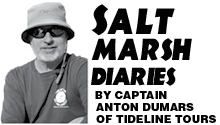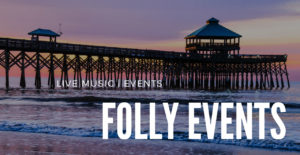THE SLOWER YOU GO THE LESS DAMAGE YOU DO
 “The slower you go, the less damage you do.” “Always leave yourself an escape route.” These words came from my boss during the first few days of work at Bohicket Marina. As such, my professional mariner’s career began. I already had my own boat. “Lickety Split” was a 1959 Simmons Sea Skiff, but only forward gear worked — no reverse or neutral. I’d point the boat in the proper direction then hit the starter. The old outboard didn’t idle well either. Often, I had to start the engine with the throttle fully advanced, an action that thrust me away from the boat landing as if on a rodeo bull. Return landings were just as clumsy.
“The slower you go, the less damage you do.” “Always leave yourself an escape route.” These words came from my boss during the first few days of work at Bohicket Marina. As such, my professional mariner’s career began. I already had my own boat. “Lickety Split” was a 1959 Simmons Sea Skiff, but only forward gear worked — no reverse or neutral. I’d point the boat in the proper direction then hit the starter. The old outboard didn’t idle well either. Often, I had to start the engine with the throttle fully advanced, an action that thrust me away from the boat landing as if on a rodeo bull. Return landings were just as clumsy.
At the marina, I learned about the effect of wind and current. I learned about how boats steer from the stern (back) due to the rudder location. To successfully maneuver a boat, the stern needs room to move about. Otherwise, you hem yourself into a situation with no escape.
Daily at Bohicket, I caught lines for million-dollar sports fisherman. Black diesel smoke and engine revs sometimes personified the captain’s ego. With the grace of a ballet dancer, experienced captains negotiate monstrously large boats effortlessly back into slips. Twin-engine boats, aided by the torqueing thrust of two propellers, rotate the vessel as if mounted on spindles. Single engine boats backed into position by shifting the stern left or right with a progression of forward propeller thrusts against the rudder.
Mistakes were costly. Most happened to the inexperienced, but not all. These wrecks tended to unfold in slow motion. Bystanders and spectators watch in awe as tons of force splintered fiberglass and wood. One such event, in which a 50-foot boat came to lay sideways across the bow of three other large yachts, prompted the owner to dramatically fire the captain on the spot. Another wreck occurred as a greenhorn captain backed his 46-foot sailboat out of the slip against a heavy flood tide and southwest wind. He turned the vessel as if it were a car, positioning the boat sideways to the docks. Black diesel smoke and frantic shouts from passengers indicated recognition of a problem. In what seemed like minutes, I watch this multi-ton boat slam sideways into three boats at once. With the boat still at full throttle in forward gear, it continued crashing across boats, crushing an outboard and deflating a dingy. The bow pulpit splintered into a docked sports fisherman, whiplashing the mast and rigging as the vessel came to an abrupt stop. Passengers quietly melted away from the boat, abandoning their captain.
I watched and learned. After a while, I earned the opportunity to operate large boats. Drawing from observing the experienced, I shifted the stern with a subtle gear change. I rotated on an axis with propeller thrusts. I slid the large vessels gracefully back into the slip. I gave orders on line handling, all without wetting my pants. Now almost 30 years later, remembering those first instructions, I still move slowly around the docks and always leave myself an escape route.
Anton owns and operates Tideline Tours located at 103 East Cooper on Folly Beach. Come by for a visit or sign up for a Tideline Adventure! Visit www.tidelinetours.com or email saltmarshadventure@gmail.com or call 843-813-5009

